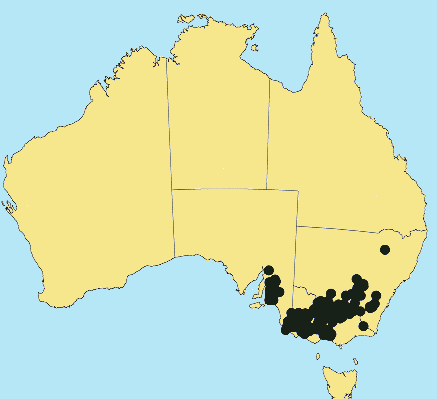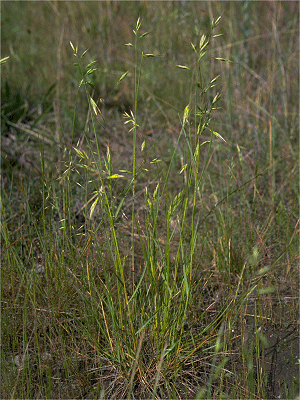Rytidosperma duttonianum (Cashmore) Connor
& Edgar. New Zealand J. Bot., 17(3): 332 (1979).
Classification. (GPWG 2001) : Subfamily Danthonioideae. Tribe
Danthonieae.
Basionym and/or
Replacement Name: Danthonia
duttoniana Cashmore, Comm. Austr., C.S.I.R., Bull. 69(app.): 72, f..
1932.
Type of Basionym or
Protologue Information: LT: Cashmore Ga-65, 2 Dec 1932, Australia:
South Autralia: Werribee (AD; ILT: K, NSW-19682). LT designated by Vickery,
Contr. New South Wales Herb. 2(3): 304 (1956).
Recent synonyms:
Notodanthonia duttoniana (Cashmore) Veldkamp, Austrodanthonia
duttoniana (Cashmore) H.P. Linder.
Key references
(books and floras): [2002] D.Sharp & B.K.Simon, AusGrass, Grasses of
Australia, [2006] J.Jessop, G.R.M.Dashorst, F.M.James, Grasses of South
Australia (289), [2008] S.W.L.Jacobs, R.D.B.Walley & D.J.B.Wheeler, Grasses
of New South Wales (143).
Illustrations:
[2006] J.Jessop, G.R.M.Dashorst, F.M.James, Grasses of South Australia (290, Fig. 224), [2008] S.W.L.Jacobs,
R.D.B.Whalley & D.J.B.Wheeler, Grasses of New South Wales, 4th edn
(143).
Derivation: L.
-ana, indicating connection. In honor of J. Dutton (1863-) field
assistant, Bathurst Agricultural Station, Australia.
Habit.
Perennial. Culms erect, 40–110 cm tall, 1–2 mm diam. Mid-culm nodes glabrous.
Ligule a fringe of hairs, 0.5 mm long. Leaf-blades conduplicate, 10–20 cm long,
2–3.5 mm wide.
Inflorescence.
Inflorescence solid, a panicle. Panicle ovate, 4–12 cm long, with spikelets
clustered towards branch tips.
Spikelets.
Spikelets pedicelled. Fertile spikelets many flowered, with at least 2 fertile
florets (5–10), comprising 5–10 fertile floret(s), with diminished florets at
the apex, cuneate, laterally compressed, 11–20 mm long.
Glumes. Glumes
similar, thinner than fertile lemma. Lower glume elliptic, membranous, much
thinner on margins, without keels, 7 -nerved. Upper glume elliptic, 11–20 mm
long, membranous, without keels, 7 -nerved.
Florets.
Fertile lemma 2.8–4 mm long, without keel, 9 -nerved. Lemma apex lobed, awned,
3 -awned. Median (principal) awn from a sinus, 11–15 mm long overall, with a
twisted column. Column 4–6 mm long. Lateral lemma awns present. Palea apex
dentate. Lodicules present. Anthers 3. Grain 1.6–2.2 mm long.
Continental
Distribution: Australasia.
Australian
Distribution: South Australia, New South Wales, Victoria.
South Australia:
Flinders Ranges, Northern Lofty, Murray, Southern Lofty, South-eastern. New
South Wales: Southern Tablelands, Central-Western Slopes, South-Western
Slopes, South-Western Plains. Victoria: Gippsland Plain, Grampians,
Midlands, Murray Mallee, Otway Plain, Riverina, Volcanic Plain, Wannon,
Wimmera.
Notes. Most
similar to R. caespitosum, from which it is best separated by the width
of the florets, the shape of the palea, the lobed inflorescence and the shiny
golden-brown lemmas. However, some collections from Victoria cannot be
determined with confidence, as they may lack the gold-backed lemma character.
South-east
Australia from Dubbo to Adelaide, altitude 150–600 m, swampy ground,
waterlogged in rainy season, often on heavy clays, or in moist seepages, or on
Tablelands often in only slightly damp habitats. Flowers Nov.





